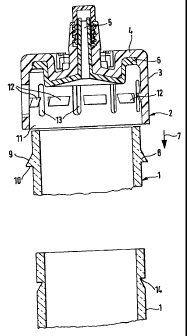Some of the information on this Web page has been provided by external sources. The Government of Canada is not responsible for the accuracy, reliability or currency of the information supplied by external sources. Users wishing to rely upon this information should consult directly with the source of the information. Content provided by external sources is not subject to official languages, privacy and accessibility requirements.
Any discrepancies in the text and image of the Claims and Abstract are due to differing posting times. Text of the Claims and Abstract are posted:
| (12) Patent: | (11) CA 2416565 |
|---|---|
| (54) English Title: | SYRINGE WITH A BARREL HOLDING A FLUID MEDIUM AND HAVING A SEALING CAP |
| (54) French Title: | SERINGUE AVEC FUT PERMETTANT DE CONTENIR UN LIQUIDE ET EQUIPEE D'UN CAPUCHON OBTURATEUR |
| Status: | Deemed expired |
| (51) International Patent Classification (IPC): |
|
|---|---|
| (72) Inventors : |
|
| (73) Owners : |
|
| (71) Applicants : |
|
| (74) Agent: | MARKS & CLERK |
| (74) Associate agent: | |
| (45) Issued: | 2009-12-08 |
| (86) PCT Filing Date: | 2001-08-01 |
| (87) Open to Public Inspection: | 2002-04-04 |
| Examination requested: | 2006-03-30 |
| Availability of licence: | N/A |
| (25) Language of filing: | English |
| Patent Cooperation Treaty (PCT): | Yes |
|---|---|
| (86) PCT Filing Number: | PCT/EP2001/008896 |
| (87) International Publication Number: | WO2002/026296 |
| (85) National Entry: | 2003-01-29 |
| (30) Application Priority Data: | ||||||
|---|---|---|---|---|---|---|
|
A syringe is provided with a barrel 1 holding a fluid medium and a sealing cap
that is
put on the outlet end of the barrel. The barrel 1 in the section that can be
inserted into the cap
has a first locking element 8 on the outside. The sealing cap 2 in the
corresponding section
has interactive second locking elements 12 on the inside. In order that the
sealing cap can be
put onto barrel with little force and thus less cracking occurring, the cap
has a plurality of
second locking elements 12 that are arranged peripherally. In each case, an
expansion section
13 is provided in the wall of cap 2 between each pair of adjacent locking
elements 12.
L'invention concerne une seringue composée d'un cylindre (1) recevant un milieu liquide et d'un capuchon de fermeture logé côté sortie. Le cylindre (1) présente un premier élément d'encastrage (8) sur l'extérieur de la partie destinée à être introduite dans le capuchon. Le capuchon (2) présente sur l'intérieur de ladite partie des deuxièmes éléments d'encastrage (12) interagissant avec le premier. L'invention vise à permettre une mise en place avec une force réduite du capuchon de fermeture sur le cylindre (1), et à réduire par conséquent le risque de rupture. A cet effet, le capuchon (2) présente une pluralité de deuxièmes éléments d'encastrage (12) logés dans le sens périphérique. Une partie d'expansion (13) est prévue dans la paroi du capuchon (2) respectivement entre deux éléments d'encastrage (12) adjacents.
Note: Claims are shown in the official language in which they were submitted.
Note: Descriptions are shown in the official language in which they were submitted.

For a clearer understanding of the status of the application/patent presented on this page, the site Disclaimer , as well as the definitions for Patent , Administrative Status , Maintenance Fee and Payment History should be consulted.
| Title | Date |
|---|---|
| Forecasted Issue Date | 2009-12-08 |
| (86) PCT Filing Date | 2001-08-01 |
| (87) PCT Publication Date | 2002-04-04 |
| (85) National Entry | 2003-01-29 |
| Examination Requested | 2006-03-30 |
| (45) Issued | 2009-12-08 |
| Deemed Expired | 2016-08-01 |
There is no abandonment history.
Note: Records showing the ownership history in alphabetical order.
| Current Owners on Record |
|---|
| BAYER INTELLECTUAL PROPERTY GMBH |
| Past Owners on Record |
|---|
| BAYER SCHERING PHARMA AKTIENGESELLSCHAFT |
| SCHERING AKTIENGESELLSCHAFT |
| WITOWSKI, NORBERT |